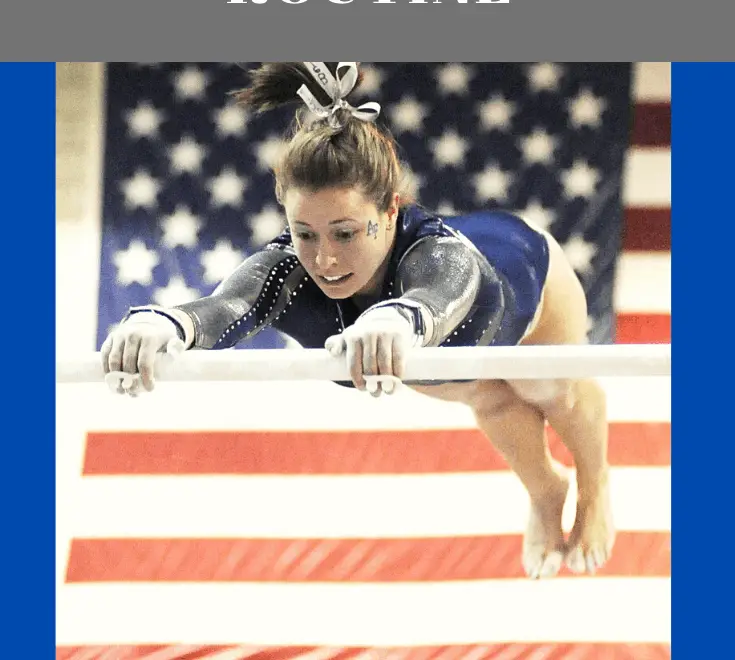This post has been updated to reflect the 2021-2029 compulsory routine changes.
Are you a Level 5 coach or gymnast? In my state, we don’t have a lot of Level 5 gymnasts, but there are some! I usually get to judge some nice Level 5 bars throughout the season, and it’s so pretty when it’s done well. The Level 5 bar routine is a great routine for learning progressions toward higher level skills. Today we’ll talk about how to perform those skills to get a great score.
Level 5 Bar Skills
Each skill in the Level 5 bar routine has specific deductions for each skill. These deductions relate to the technique that is expected for the skill. In addition to these deductions, there are general execution deductions that judges can apply to all skills. We’ll talk more about those in a minute. Finally, a judge can take general routine deductions, which are deductions for the overall impression of the routine. If you’re curious about that, here’s an article that discusses general deductions in detail.
General Execution Deductions
General execution deductions are deductions that judges use for any major element (skill) in a routine. Here is a list of common general execution deductions that could occur during a bar routine:
- Foot form – 0.05
- Leg separation – Up to 0.20
- Body alignment/position/posture in major elements – Up to 0.20
- Bent arms or legs (max deduction at 90° bend) – Up to 0.30
- Balance errors – Up to 0.30
- Fall (on or off the apparatus) – 0.50
- Repositioning of hands in support or feet in squat on – 0.10
- Alternate hand grasp – 0.20
- Extra cast or swing – 0.30 (maximum 0.50 if >1)
- Supplementary support to regain position – 0.30
- Insufficient internal body amplitude – up to 0.20
- Insufficient external amplitude away from bar – 0.20
- Brush/touch on apparatus or mat with foot or feet – Up to 0.10
- Hit on apparatus with foot – 0.20
- Hit on mat with feet – 0.30
- Full weight on mat with feet – 0.50
Specific Execution Deductions
Each skill has a set of specific deductions that apply only to that skill. Here’s a breakdown of these deductions, skill by skill, for the Level 5 bar routine.
Glide kip
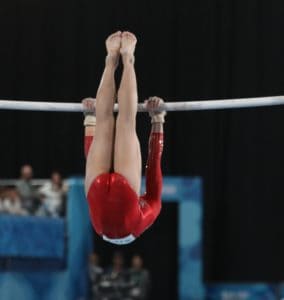
The gymnast should jump off both feet into the glide swing, or she could receive a 0.10 deduction. If she performs a run-out glide, it is a 0.30 deduction. The feet should lead and stay in front of the body during the glide (up to 0.10 deduction). Her body should extend completely at the end of the swing, or she can lose up to 0.20 for lack of extension in the glide. If the gymnast fails to close her legs at the end of a straddle glide, it is a 0.10 deduction.
Cast above horizontal (straight or straddled)
In Level 5 bars, the amplitude requirement for the cast increases slightly, compared to Level 4. Now, the gymnast is expected to cast above horizontal. Even 1 degree above horizontal meets this requirement!
Cast angles are determined by drawing an imaginary line between the shoulders and the lowest body part. This means that if the gymnast has an arched body, the line would be drawn between her shoulders and her belly. If she is piked, the line would be between her shoulders and feet. If she casts with a straight body, the line would go straight down the length of her body.
The Level 5 cast may be performed with a straight body, or a piked-hip straddle technique. If the gymnast uses the straddle technique, the angle of the cast is determined by the angle of the body once the feet join together. If the cast is above horizontal, but the feet are still apart, the judge will evaluate the angle once the feet are together. Sometimes this means there will still be an amplitude deduction even if the cast appeared to meet the requirement. Make sure the feet come together while the angle is still above horizontal for no deduction!
The amplitude deductions for the cast vary depending on the angle the cast reaches. If the cast is at least 1° above horizontal, there is no amplitude deduction. If the angle is horizontal-45° below horizontal, the deduction is 0.05-0.20. If the cast angle is 46° or more below horizontal, the deduction is 0.25-0.30. Remember, if a gymnast also has a body position error, she will receive deductions for the error, AND the amplitude.
The cast should be performed with straight body alignment from the shoulders to the feet (unless using the straddle technique), and a hollow position in the chest. The other specific deduction for the cast is for poor body alignment (up to 0.20). Often, a deduction for bent arms can be applied because the gymnast initiates or finishes the cast with bent arms.
Circling Skill
In Level 5 bars, there are three options for circling skills: clear hip circles, sole circles, and stalder circles. Each gymnast and coach can work together to determine which skill best meets the gymnast’s skill level and looks the cleanest.
Circling Option 1: Clear hip circle above horizontal
The gymnast should maintain a hollow body position during the clear hip circle. If she is excessively arched or piked on either the downswing or upswing, she could receive a deduction of up to 0.20. She should finish her clear hip circle, with wrists shifted, above horizontal. The amplitude deductions for the clear hip are the same as the cast, with 0.30 the maximum amplitude deduction. If the hips touch the bar at the completion of the upswing, the gymnast will lose the value of the skill, a 0.60 deduction. There is also a deduction of up to 0.10 if the gymnast does not show control as she moves into the glide after the clear hip.
In addition to these specific deductions, common general execution deductions include bent arms (up to 0.30), leg separation (up to 0.20), foot form (0.05), and occasionally bent legs (up to 0.30).
Circling Option 2: Backward sole circle to clear support
There are three allowable techniques when performing the sole circle. The three techniques are:
- Cast, pike-on, feet between the hands or slightly outside of the hands in a narrow straddle
- Step-on technique, placing both feet between the hands
- Tight arch-snap to pike-on, feet between the hands or slightly outside the hands in a narrow straddle
Specific execution deductions include bent legs during the circle (up to 0.30), lack of control into the glide (up to 0.10), and excessive arch on the upswing (up to 0.20). If there is support of weight on the feet at the completion of the upswing, the deduction is 0.60, or loss of the value of the element. The gymnast is expected to open the shoulders to achieve the clear support, and if there is a complete lack of open with support of the feet, this deduction is applied.
The amplitude deductions for the sole circle are different from the clear hip circle. First, the line for the angle is drawn from the shoulders to the hips. The hips are not required to open at the completion of the circle. Also, the required angle of completion is 45° from vertical from the shoulders to the hips. If the gymnast finishes between 46° from vertical and horizontal, the deduction is 0.05-0.20. Below horizontal, she will lose 0.25-0.30.
Similar to the clear hip circle, the gymnast can also receive general execution deductions for errors such as bent arms, leg separations, and foot form.
Circling Option 3: Backward stalder to clear support
The amplitude deductions for the stalder circle are the same as the sole circle. Again, the line for the angle is drawn from the shoulders to the hips. The hips do not need to open at the completion of the circle. Again, the expected angle of completion is 45° from vertical from the shoulders to the hips. If the gymnast finishes between 46° from vertical and horizontal, the deduction is 0.05-0.20. Below horizontal, she will lose 0.25-0.30.
If the gymnast finishes the circle in a straddle “L” position rather than a clear support, it will be considered a backward seat circle. In this case, she will lose the value of the skill, a 0.60 deduction.
Other specific deductions include excessive arch on the upswing (up to 0.20) and lack of control into the glide (up to 0.10). The same general deductions apply to the stalder circle as to the other circling skills: bent arms, leg separation, foot form, and bent legs.
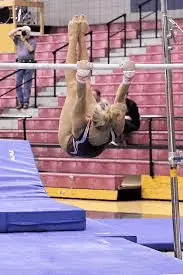
Glide kip
After the circling skill of choice, the gymnast may perform either a piked or straddled kip. The feet should lead during the glide, or a deduction of up to 0.10 can be applied. As in the first kip, the body should extend fully during the glide (up to 0.20). If a straddle glide is performed, the legs must close at the end (0.10).
Another common deduction on the kip is contacting the floor with the feet. If the feet brush the floor, it is a 0.10 deduction. If the feet hit the floor, but it is less than full weight support, a 0.30 deduction applies. Full weight on the feet during a hit on the mat will incur a 0.50 deduction.
Common general execution deductions include bent arms (up to 0.30), bent legs (up to 0.30), leg separation (up to 0.20), and body position errors (up to 0.20). If the gymnast stops after the kip, and does not connect immediately to the squat on, she can receive a rhythm deduction, as well as an extra swing deduction if the feet pump back and forth.
Squat-on/Pike-on/Sole circle
To transition to the high bar, the gymnast has a choice of three skills: squat-on, pike-on, and sole circle.
If the gymnast performs the sole circle, she has a choice of three entry techniques:
- Squat on start (knees bent)
- Pike-on start (knees straight)
- Late drop start (late drop – step in technique ok, knees bent or straight)
For each of these skills there is a deduction of 0.20 for alternate foot placement. A deduction of 0.05 is applied if only the hips lift into the cast, and the legs do not rise. General deductions are also applied for bent arms, leg separations, and steps on the bar.
Long hang kip
The only specific deduction for the long hang kip is an up to 0.20 deduction for failure to swing near horizontal. Of course, general deductions apply both to the kip and to the jump to the high bar. Common deductions during the jump are bent legs, leg separation, and poor body position. The body position, as stated in the text, should be straight-hollow during the jump. During the kip, these same deductions apply, and it is also common to see bent arms at the end of the kip. Just like the low bar kips, if the gymnast stops between the kip and the cast, a rhythm deduction is taken, and an extra swing deduction applies if the gymnast pumps her legs.
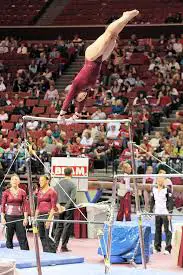
Cast above horizontal
The cast on the high bar is expected to finish above horizontal, just like the cast on the low bar. The casting deductions are exactly the same as the low bar cast.
It is acceptable to perform a straight body cast on the low bar and a straddle cast on the high bar, or vice versa. Feel free to “mix and match” the casts, to the advantage of your gymnast!
Long hang pullover
The long hang pullover should start with a good tap swing, showing a tight arch position under the bar (0.10 deduction). Next, the gymnast should kick her feet into a hollow body position for the pullover. Piking excessively will result in an up to 0.20 deduction. Finally, she should continue immediately into the underswing. The hands must stay in contact with the bar as the wrists shift. A 0.30 deduction will be applied if the hands release the bar. If a giant swing is performed before the hips come back to the bar, the gymnast will incur a deduction of 1.00.
It’s common to see the arms bend as the gymnast shifts her wrists and begins the underswing. Arm bend will receive a deduction of up to 0.30. Also, many gymnasts have a rhythm error during the connection of the pullover and the underswing. When the elements do not connect directly together, a deduction of up to 0.20 can be applied.
If the gymnast has too much momentum after the long hang pullover, she is allowed to perform a back hip circle before the underswing with no penalty. Execution deductions would apply to the back hip circle.
Underswing, counterswing to 15° below horizontal
Before I go into the deductions, let’s review a couple of definitions.
Underswing = a swing that starts with the gymnast on top of the bar, she drops back in a hollow position and extends the feet upward (Level 2 dismount)
Counterswing = a backward swing, or upswing, toward the low bar.
Tap swing = a forward swing away from the low bar.
Underswing
The underswing should be performed by keeping the bar at the thighs, and opening the shoulders as the hips rise. Thigh contact on the bar MUST occur between the long hang pullover and the underswing, or a 0.20 deduction is taken. If the hips touch the bar during the underswing, it is a 0.20 deduction. There is no deduction for the thighs touching the bar. The head should stay neutral (up to 0.10) and the body position should still be straight-hollow (up to 0.20 if it is not).
Counterswing
The swing requirements in Level 5 bars are slightly higher than in Level 4. The gymnast needs to swing to 15° below horizontal, and an up to 0.20 deduction can be applied if she does not reach this amplitude. Just like Level 4, the angle is measured from the shoulders to the hips.
The body should be in a straight line from the hands to the hips, the chest should be hollow, and the hip angle should be rounded. If this body shape does not occur, there could be a deduction of up to 0.20. It’s acceptable for the hips to pike in order for the feet to clear the low bar, but excessive piking could incur a deduction.
General deductions for bent legs, bent arms, foot form, and leg separations also apply, in addition to the specific amplitude and body position deductions for the swings.
Tap swing, counterswing to 15° below horizontal
Tap Swing
Next, the gymnast should perform a tap swing, again showing a slight arch at the bottom of the swing to initiate the tap. A 0.10 deduction is taken if the gymnast does not show this slight arch.
The gymnast is allowed to use an “early tap” technique, but the tap must be initiated on the downswing. During the upswing, if the body is arched over the low bar, or if the hips are open and extended with the feet over the low bar, a flat 0.30 deduction will be taken. The legs are allowed to straddle or stay together during the downswing. If the forward swing does not reach the height of the high bar, judges can apply an amplitude deduction of up to 0.20.
Counterswing
Then, the gymnast should perform a second counterswing. She should return to the straight-hollow body position on the upswing. There is a deduction of up to 0.20 for poor body position. The same amplitude deductions and arch deductions apply as in the first counterswing. Again, general errors such as bent arms, bent legs, leg separations, and foot form will be deducted.
Flyaway dismount (10.0 Start Value) OR Swing 1/2 Turn dismount (9.50 Start Value)
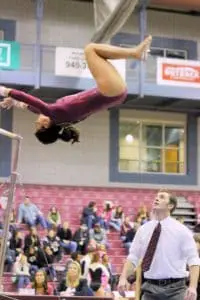
Flyaway (10.0 Start Value)
Flyaways in Level 5 bars can be performed in a tuck, pike, or layout position, and all of these are worth the same. It’s worth trying them each out to see which one looks the cleanest and most dynamic!
During a tuck flyaway, the hips and knees must bend to at least 135°, but ideally 90°. Lack of hip and knee bend can each incur a deduction of up to 0.20. The pike flyaway requires a hip bend of at least 135°, and ideally 90°, with an up to 0.20 deduction for insufficient pike. In both the tuck and pike flyaways, the gymnast is then expected to open her hips and stretch her body before landing (up to 0.20 deduction).
During the layout flyaway, the body position should be straight-hollow throughout. There are deductions of up to 0.20 for failure to keep the body in the straight-hollow position during the salto, and another up to 0.20 for piking down. The best idea, if the gymnast is having difficulty maintaining the layout position, is to just have her perform a flyaway that shows a definite pike throughout.
Regardless of the body position, the flyaway should be initiated with a tap, and a 0.10 deduction is taken if no slight arch is shown at the bottom of the swing. On the upswing, the gymnast should show a straight-hollow position (up to 0.20 deduction). Deductions for insufficient height are applied based on the gymnast’s amplitude relative to the high bar. There is no deduction if she is at or above the height of the high bar. If the flyaway occurs 1°-45° below the height of the high bar, an up to 0.20 deduction is taken. For flyaways more than 45° below the height of the high bar, a 0.25-0.30 deduction is applied (and the judge might lose a year or two off her life!).
Dismount: Tap swing forward with 1/2 turn (9.50 Start Value)
First, the dismount should be initiated with a slight arch (tap) at the bottom of the swing, with a 0.10 deduction applied if the tap is missing. Next, the gymnast should return to the straight-hollow position on the upswing (up to 0.20 deduction). If the 1/2 turn begins prior to 45° below the high bar, a deduction of up to 0.20 can be taken. Finally, the 1/2 turn must be completed before the gymnast re-contacts the bar with her hand (up to 0.20 deduction). If the free hand never comes back into contact with the bar, a flat 0.30 deduction is taken. The gymnast does not have to grasp the bar with the free hand, but she does at least need to touch the bar.
Closing Thoughts
To sum it up, the best Level 5 bar routines are performed with excellent body position, straight arms, and straight legs throughout. Don’t sacrifice body position for amplitude on casts and circling skills, because the body position errors commonly add up to much greater deductions than the amplitude deductions. Not to mention, poor technique will make it more difficult to learn the more difficult skills!
Level 5 bars is beautiful when performed well, and it’s a great lead up routine to prepare gymnasts for optionals. Do you have questions about Level 5 bars? Drop them in the comments!
References
USA Gymnastics Compulsory Handbook, 2021-2029.
Further Reading
How to Perfect Your Level 3 Bar Routine
How to Perfect Your Level 4 Bar Routine
The Best Gymnastics Grips You Need to Use
